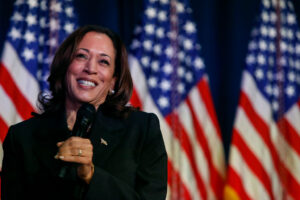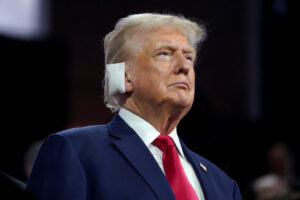Joe Biden is out. For Democrats, that is welcome news. But the party will not rouse Americans by simply throwing the car keys to Vice President Kamala Harris. To stir the people, Democrats need an open convention. By grabbing the veritable lapel of the American public, the party has a chance to steal Trump’s momentum — and America’s attention. In fact, history shows that in the recent past, this was exactly how presidents were nominated.
America’s presidential cycles, dubbed “The Circus” by a Showtime docuseries, have only recently become punishingly absurd ultra-marathons — the 2024 presidential election cycle officially began with the first Republican debate — 444 days before election day. Parties used to choose nominees at quadrennial summer conventions at which delegates from each state would gather to nominate a presidential ticket. Then over several hot summer days, candidates debated while insiders took stock of their political chops and electability. These conventions were essentially primaries writ small and in-brief. Delegates voted. Nominees were chosen. And the consequent presidential campaigns were measured in days (approximately100) — not years.
But choosing presidents via these closed sessions of party insiders understandably had its detractors. And in the early 20th century, good government progressives felt the need to challenge the monopoly power of party bosses. And so, the goo-goos, as the press labelled them, established presidential primaries. Reformers believed primaries would curb the power of party bosses, ease corruption, and make democracy more responsive to popular sentiments. By 1916, 20 scattered states hosted presidential primaries. But dubbed “beauty contests” by journalists, the primaries held no actual power. A candidate could prove their electability by winning one, but that state’s convention delegates were not required to support them. Voters turned out sporadically. Most candidates ignored them.
In postwar America, however, that calculus changed. In 1930, fewer than one-in-five Americans held high school diplomas; a paltry 3.9% graduated from college. By the Seventies, those numbers had tripled. Meanwhile, per capita GDP had nearly quintupled. In this milieu, a new mass demographic was born, the educated middle class. A mix of economics and vocation, the educated middle class are lawyers, engineers, teachers, doctors, and journalists. Not quite rich but comfortably affluent, they were blessed with leisure time. And this class no longer treated politics as spectator sport — they wanted to participate. Participatory democracy, to them, ensured greater accountability.
In 1952 their presidential candidate, Tennessee senator Estes Kefauver, challenged Harry Truman in the New Hampshire Democratic primary. Folksy, cerebral, and media savvy, the Tennessean clubbed the sitting president, 54-46%. The drubbing forced Truman into retirement; Kefauver went on to win 12 of 15 primary contests. But Kefauver never stood a chance of being nominated. Party bosses knew a secret the larger public did not — the Tennessean’s alcoholism. Kefauver’s boozing was prodigious even in an era in which crapulence was the norm. The party bosses won out. But Kefauver made the primaries, and the educated middle class, matter.
Instead of Kefauver, Democrats, at the 1952 open convention, nominated Illinois Governor, Adlai Stevenson. Generations before Barack Obama, the Illinoisan tickled the educated middle class to their cockles with stirring rhetoric. Forgetting Kefauver, they dubbed themselves Stevensonians, and flocked into the Democratic Party. In so doing, the educated middle class gained power in the Democratic Party far beyond their numbers.
While primary contests did matter, convention delegates still possessed the ultimate power to choose a nominee. In 1960, erstwhile Stevensonians boosted John Kennedy to primary wins. This, along with Kennedy’s charisma, pushed party bosses to relent. But eight years later, Vice President Hubert Humphrey, who never even entered a primary contest, took the nomination over Senator Eugene McCarthy, who had split primary wins with the assassinated Robert Kennedy. Outraged at the disregard of primary voter sentiment, young protesters in league with old Stevensonians tore Chicago asunder. Afterwards, activists championed the 1970 “McGovern reforms”. This fundamentally changed the nominating process. Starting in 1972, the reforms made primaries and caucuses binding. If a candidate won a state contest, delegates were compelled to support them at the convention. “The Circus” was born.
Party bosses no longer ruled; But the educated middle class did.
On average, 27% of registered voters turn out for primaries. And these voters are overwhelmingly from the educated middle class. In any election, the college degreed are 50% more likely to vote than a high school graduate. But this is even truer for primaries. The standard primary goer is twice as likely to have studied beyond a bachelor’s degree as the average voter. So the McGovern reforms, far from a democratic revelation, have given the educated middle class an outsized voice in American politics. More partisan and ideological than the normie voter, they donate, volunteer, and vote for candidates who reside on the ideological edge of their party.
Well-intentioned, the McGovern reforms gave birth to our hyper-partisan presidential politics, the toxins of which now flow downstream to contaminate even local races.
Yes, the Democrat’s normie-in-chief, Joe Biden, won the 2020 nomination. Covid and the spectre of Trump prematurely curtailed the primary season. With every other major contender, except Pete Buttigieg, vying for the Brahmin Left’s vote, Biden had the normie lane to himself.
But there is nothing sacrosanct about the present system. In clinching the GOP and Democratic nominations, Trump and Biden won approximately 10% of all voters in the 2024 primaries and caucuses. This is scarcely “Vox Populi, Vox Dei”.
But an open convention would be a television show without a script. Delegates, on live national television, debate and mull the strengths and weaknesses of the major candidates. Every state delegation votes. Those votes would be weighted to each state’s overall population. It is the candidate’s job to woo the delegation. The first candidate to win a majority of delegates votes, 1,990, votes nabs the nomination.
Presided over by the educated middle classes, primaries offer only the illusion of direct democracy and legitimacy. Whereas a motley collection of 4,672 convention delegates, mostly officeholders and activists, is an imperfect, yet reasonably fair reflection of the Democratic ranks. Women, minorities, union members, and local party officials comprise the delegate ranks. The nominee, by necessity, will be someone with appeal to the party’s diverse ranks. The novelty of an open convention will bring other-worldly ratings. The eventual nominee will be awash in campaign funds.
But the political geography is clear. To win, a Democrat must sweep Michigan, Wisconsin, and Pennsylvania. A ticket combining the popular Democratic governors of two of those three states, Michigan’s Gretchen Whitmer and Pennsylvania’s Josh Shapiro, possesses an enormous homefield advantage. An open convention will allow Democrats in the coming weeks to vet candidates and weigh all possibilities. In the coming weeks, delegates will watch televised debates. They can even attend a live campaign event and sense the crowd’s electricity. They have plenty of time to assess the cut of a candidate’s jib and how that jib is received by their Democratic friends, family, and party ranks.
Ninety-two years ago, in 1932, Democrats met in Chicago, to nominate a president. The global economy was in freefall. Fascists were on the march. After several rounds of convention ballots, Southern, Northern, conservative and progressive Democrats coalesced around FDR. In an era before the Internet, jet airplanes, television, or Zoom, Roosevelt ran a successful 100-day national campaign, from a wheelchair.
Next month, Democrats, like 1932, convene in Chicago. The stakes are jarringly similar.
An open convention is Trumpism’s Kryptonite. Trump feeds on political cynicism. The fission generated by actual democratic competition is a living, tangible negation of Trump’s nihilism.
An open convention offers the best and final chance to nominate a president who, like the Biden of old, understands normie lives and speaks fluent Middle American. That, and only that, can beat Donald Trump.
Disclaimer
Some of the posts we share are controversial and we do not necessarily agree with them in the whole extend. Sometimes we agree with the content or part of it but we do not agree with the narration or language. Nevertheless we find them somehow interesting, valuable and/or informative or we share them, because we strongly believe in freedom of speech, free press and journalism. We strongly encourage you to have a critical approach to all the content, do your own research and analysis to build your own opinion.
We would be glad to have your feedback.
Source: UnHerd Read the original article here: https://unherd.com/



